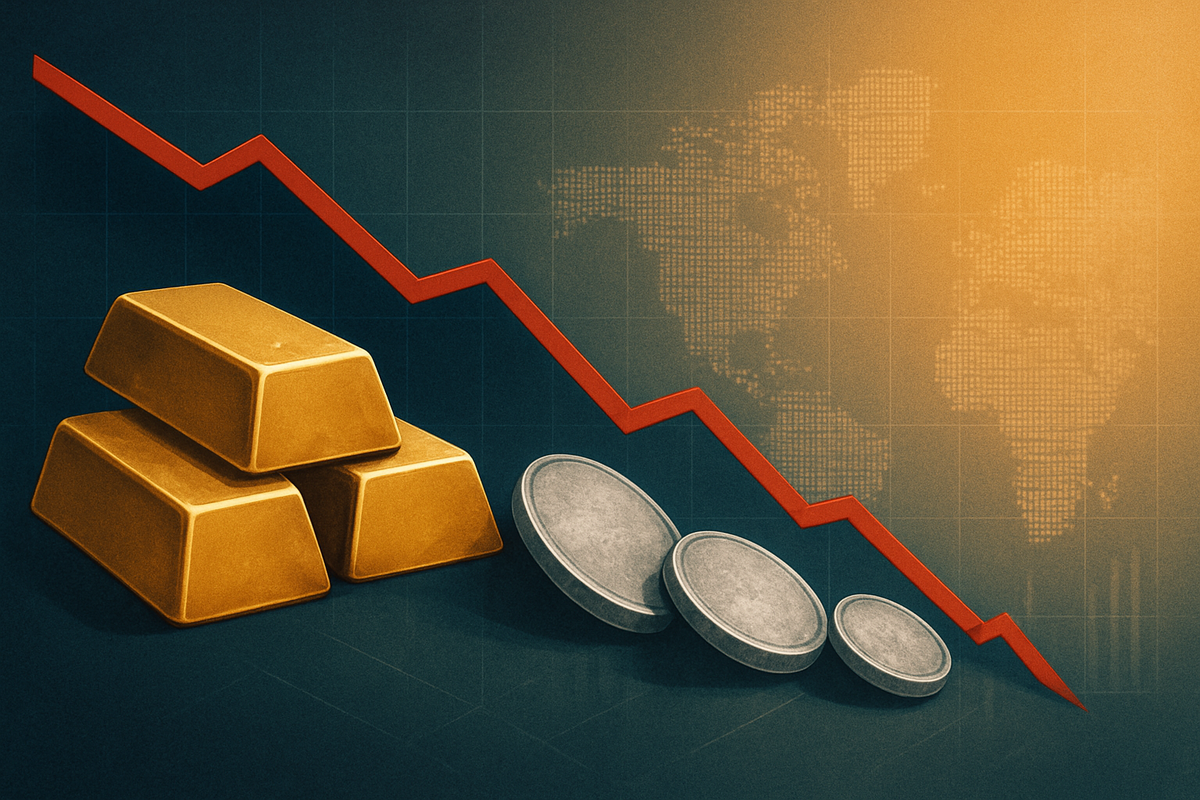
In a significant shift in the precious metals market, gold prices have recently slipped below the critical $4,000 per ounce mark, while silver has retreated towards $46 per ounce. This notable correction, observed on October 27, 2025, follows a period of robust rallies for both metals and is primarily attributed to a broad easing of safe-haven demand. Investors are increasingly shifting capital towards riskier assets, buoyed by improving global economic sentiment and a perceived reduction in geopolitical uncertainties, particularly surrounding US-China trade relations.
This downturn marks a pivotal moment for the precious metals sector, signaling a potential recalibration of market expectations. While the immediate implications point to a decrease in investor anxiety, the long-term outlook for gold and silver remains a subject of intense debate, with underlying economic uncertainties and central bank policies still casting a shadow over the future.
Detailed Market Correction and Contributing Factors
The recent downturn in precious metals has been sharp and impactful. On October 27, 2025, spot gold experienced a substantial decline, slumping over 2% to trade around $4,028.84 per ounce. It briefly breached the psychological $4,000 threshold, hitting a low of $3,991 per troy ounce. U.S. gold futures for December delivery (COMEX: GCZ25) mirrored this trend, trading down 2.9% at $4,019.00. This single-day drop was one of gold's steepest declines in over a decade, contributing to a 3.3% loss in the preceding week. This correction comes after gold had a blistering rally earlier in October, reaching an all-time high of approximately $4,380 to $4,400 per ounce.
Silver, often referred to as "poor man's gold," followed a similar trajectory. On October 27, spot silver slipped 0.3% to $48.42 per ounce and further fell to $46.61 USD/t.oz, marking a 4.08% decrease from the previous day, observed trading near $46.47 per ounce. MCX Silver December contracts were down 0.83% at ₹146,241 per kilogram. Silver prices have retreated more than 16% from their all-time high of approximately $54-$54.50 per ounce reached earlier in October. The spot silver price also fell 3.8% to $46.75 per ounce, following an 11.3% plunge in the previous week, which was its steepest weekly decline since September 2020.
The primary catalyst for this significant correction is the easing of safe-haven demand, driven by several key factors. Optimism surrounding a potential comprehensive trade agreement between the United States and China has been a significant driver, de-escalating trade tensions and boosting overall market confidence. Concurrently, a strengthening U.S. dollar has made dollar-denominated precious metals more expensive for international investors, further dampening demand. These developments have fostered an increased appetite for riskier assets, leading to rallies in global stock markets and a shift of capital away from traditional safe havens. Furthermore, after a strong global rally that saw both metals reach record highs, many investors are engaging in profit-taking, exacerbating the price declines as prices had entered overbought territory.
Companies Navigating the Volatile Waters
The recent downturn in gold and silver prices presents a mixed bag for public companies operating within or closely tied to the precious metals sector. Mining companies, particularly those with high operating costs or significant debt, may face increased pressure on their profit margins. Companies like Barrick Gold Corp. (NYSE: GOLD) and Newmont Corporation (NYSE: NEM), two of the world's largest gold producers, will see their revenue streams directly impacted by lower gold prices. While their sheer scale and often diversified operations might cushion some of the blow, sustained lower prices could lead to reduced exploration budgets, delayed project developments, or even asset impairments. Silver miners such as Pan American Silver Corp. (NASDAQ: PAAS) and Fresnillo PLC (LSE: FRES) will similarly feel the pinch, though silver's industrial demand component offers some potential resilience.
Conversely, some sectors might find a silver lining in the metals' retreat. Jewelry retailers, for instance, could benefit from lower input costs, potentially leading to improved margins or more competitive pricing for consumers. Companies like Tiffany & Co. (NYSE: TIF) or Signet Jewelers Limited (NYSE: SIG) might see a boost in demand if lower raw material costs translate into more attractive product pricing. For industrial users of silver, particularly in the electronics, solar panel, and electric vehicle sectors, the dip in prices could offer a cost advantage, potentially stimulating production and innovation. Companies involved in these high-growth industries, such as First Solar, Inc. (NASDAQ: FSLR) or various automotive manufacturers, might see a slight positive impact on their material costs.
Investors in precious metals exchange-traded funds (ETFs) like SPDR Gold Shares (NYSEARCA: GLD) and iShares Silver Trust (NYSEARCA: SLV) will directly experience the negative impact of declining prices. While some might see this as an opportunity to buy the dip, others could face significant paper losses. The broader financial markets, however, could interpret the shift from safe-haven assets as a sign of improving economic confidence, potentially boosting equities across various sectors, including technology and industrials, as investors reallocate capital towards growth-oriented investments.
Wider Significance and Historical Context
The recent tumble in gold and silver prices is more than just a momentary blip; it reflects a significant pivot in broader financial market sentiment. This event fits into a larger trend of shifting investor focus from defensive, safe-haven assets to more growth-oriented investments, signaling increased confidence in the global economic outlook. The primary driver, easing geopolitical tensions and optimism surrounding US-China trade negotiations, suggests a potential de-risking environment. This could have ripple effects on various sectors, including reduced demand for traditional inflation hedges if central banks manage to control price pressures effectively.
Historically, precious metals have served as a barometer for global uncertainty and inflation expectations. Comparisons can be drawn to periods of significant de-escalation in global conflicts or robust economic expansions where gold and silver have seen sustained corrections. For instance, after periods of high inflation or geopolitical instability, a return to normalcy often sees investors divest from gold. The current situation, however, is unique given the unprecedented monetary policies enacted globally in recent years and the still-present underlying economic fragilities. While a strong U.S. dollar typically weighs on precious metals, the current strength is tied to renewed confidence in the U.S. economy and potentially higher interest rate expectations, further diminishing gold's appeal as a non-yielding asset.
Regulatory and policy implications are also at play. Central bank policy meetings, particularly from the US Federal Reserve, are closely watched. Expectations of potential rate cuts, while generally supportive of gold in the long term, are currently being overshadowed by immediate risk-on sentiment. If central banks signal a more hawkish stance to combat lingering inflation or if economic data disappoints, safe-haven demand could quickly re-emerge. The ongoing debate about fiscal stimulus and rising debt levels globally also provides a long-term bullish undercurrent for gold, suggesting that the current dip might be a temporary correction rather than a fundamental shift in its long-term value proposition.
The Road Ahead: What Comes Next?
Looking ahead, the precious metals market faces a period of heightened scrutiny and potential volatility. In the short term, the direction of gold and silver will largely hinge on forthcoming US inflation and employment data, as well as the outcomes of upcoming central bank policy meetings. Should economic data indicate a robust recovery and contained inflation, the current trend of easing safe-haven demand could persist, pushing prices further down. Conversely, any unexpected negative economic news or a resurgence of geopolitical tensions could quickly reignite demand for gold and silver, leading to a rebound. Investors should anticipate continued profit-taking and potential for further price discovery as the market digests these new realities.
In the long term, the outlook for precious metals remains complex but generally constructive. While the immediate focus is on easing safe-haven demand, the macro backdrop still holds supportive elements for gold. Unorthodox fiscal policies, rising global debt levels, and sustained central bank purchasing are factors that could underpin gold prices beyond 2025. Analysts generally project gold to average above $4,000 per ounce in 2026, with some forecasts even reaching $5,000 per ounce, suggesting that the current dip might be a buying opportunity for long-term investors. For silver, its dual role as a monetary metal and an industrial commodity provides a unique buffer. Strong industrial demand from burgeoning sectors like electric vehicles, data centers, and solar power, coupled with ongoing supply deficits, is expected to support silver prices in the long run, even if safe-haven demand remains subdued.
Potential strategic pivots for market participants include a re-evaluation of portfolio allocations, with a potential shift towards equities and other growth assets. Precious metals mining companies might need to focus on cost efficiency and strategic hedging to navigate lower price environments. New market opportunities could emerge for investors willing to ride out short-term volatility and capitalize on the long-term fundamentals of precious metals, especially silver's industrial demand story. Potential scenarios range from a continued bearish trend if global economic optimism holds firm, to a swift reversal if new uncertainties emerge or if central banks adopt more dovish stances than currently anticipated.
Comprehensive Wrap-Up and Investor Outlook
The recent tumble in gold and silver prices, with gold slipping under $4,000 and silver nearing $46, represents a significant market event driven by easing safe-haven demand. Key takeaways include the market's pivot towards riskier assets amid US-China trade optimism, a strengthening U.S. dollar, and widespread profit-taking after record-setting rallies. While this correction has delivered a blow to precious metals investors, it also signals a renewed confidence in the global economic outlook, which could bode well for broader equity markets.
Moving forward, the precious metals market is expected to remain dynamic. Short-term volatility will likely be influenced by upcoming economic data and central bank policy decisions. However, the long-term assessment suggests that underlying factors such as geopolitical turbulence, global debt levels, and sustained central bank demand could provide a floor for gold prices, potentially leading to a resurgence beyond the current dip. Silver, with its robust industrial applications, appears particularly well-positioned for long-term growth despite short-term fluctuations.
Investors should closely monitor global economic indicators, central bank communications, and geopolitical developments in the coming months. While the immediate trend points to a decrease in safe-haven appeal, the historical role of gold and silver as stores of value and inflation hedges means they will likely retain their importance in diversified portfolios. The current market correction might present strategic entry points for long-term investors, particularly those who believe in the enduring value of precious metals amidst ongoing global uncertainties and the increasing industrial demand for silver.
This content is intended for informational purposes only and is not financial advice





